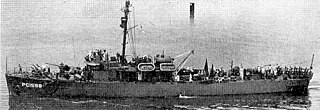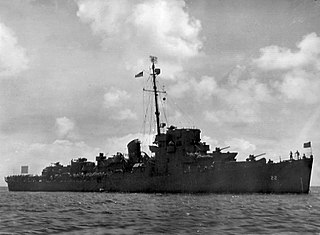
USS Acree (DE-167) was a Cannon-class destroyer escort in service the United States Navy from 1943 to 1946. She was scrapped in 1973.
USS PC-1136 was a PC-461-class submarine chaser built for the United States Navy during World War II. Shortly after the end of the war, she was renamed USS PCC-1136 when she was reclassified as a combat communications control ship. In 1956, she was renamed Galena (PC-1136), becoming the third U.S. Navy vessel so named, but never saw active service under that name.
USS PC-1138 was a PC-461-class submarine chaser built for the United States Navy during World War II. She was later renamed Lapeer (PC-1138) but never saw active service under that name.
USS PC-1142 was a PC-461-class submarine chaser built for the United States Navy during World War II. She was later renamed Hanford (PC-1142) but never saw active service under that name. Hanford was transferred to the Republic of China Navy in July 1957 and renamed ROCS Pei Chang (PC-122).
USS Annoy (AM-84) was an Adroit-class minesweeper of the United States Navy. She was laid down on 3 December 1941 at Portland, Oregon, by the Commercial Iron Works; launched on 6 April 1942; and commissioned on 2 September 1942. In 1944 she was reclassified as a patrol craft and renamed PC-1588.

USS Excel (AM-94) was an Adroit-class minesweeper of the United States Navy. Laid down on 19 December 1941 by the Jakobson Shipyard, Inc., Oyster Bay, Long Island, New York, launched on 10 May 1942, and commissioned on 11 December 1942. The ship was reclassified as a submarine chaser, PC-1598 on 1 June 1944.
USS Exploit (AM-95) was an Adroit-class minesweeper of the United States Navy. Laid down on 11 May 1942 by the Jakobson Shipyard, Inc., Oyster Bay, Long Island, New York, launched on 7 September 1942, and commissioned on 5 February 1943. The ship was reclassified as a submarine chaser, PC-1599, 1 June 1944, and reclassified again as a control submarine chaser, PCC-1599, 20 August 1945.

The second USS Fleming (DE-32), and first ship of the name to enter service, was an Evarts-class destroyer escort built for the United States Navy during World War II. While performing convoy and escort duty in the Pacific Ocean she was also able to sink one Japanese submarine and to shoot down several kamikaze planes that intended to crash onto her. For her military prowess under battle conditions, she was awarded four battle stars.

USS Wileman (DE-22) was an Evarts-class destroyer escort constructed for the United States Navy during World War II. It was promptly sent off into the Pacific Ocean to protect convoys and other ships from Japanese submarines and fighter aircraft. At the end of the war, she returned to the United States proudly displaying four battle stars.

USS Wintle (DE-25) was an Evarts-class destroyer escort constructed for the United States Navy during World War II. The ship was promptly sent off into the Pacific Ocean to protect convoys and other ships from Japanese submarines and fighter aircraft. By the time she returned to the United States at the end of the war she had been awarded three battle stars.

USS Martin (DE-30) was an Evarts-class destroyer escort constructed for the United States Navy during World War II. The ship was promptly sent off into the Pacific Ocean to protect convoys and other ships from Japanese submarines and fighter aircraft. The vessel entered service in 1943 and spent its entire career in the Pacific Ocean. Following the surrender of Japan, Martin returned to the United States and by the end of 1945, was slated for scrapping, which began in 1946.

USS Manlove (DE-36) was an Evarts-class destroyer escort of the United States Navy during World War II. She was promptly sent off into the Pacific Ocean to protect convoys and other ships from Japanese submarines and fighter aircraft. She performed dangerous work in numerous battle areas, and was awarded five battle stars.

USS Dionne (DE-261) was an Evarts-class destroyer escort of the United States Navy during World War II. She was sent off into the Pacific Ocean to protect convoys and other ships from Japanese submarines and fighter aircraft. She performed escort and antisubmarine operations in dangerous battle areas and returned home with six battle stars, a high number for a ship of her type.

USS McConnell (DE-163) was a Cannon-class destroyer escort built for the United States Navy during World War II. She served in the Pacific Ocean and provided escort service against submarine and air attack for Navy vessels and convoys. She was awarded three battle stars.

USS Bangust was a Cannon-class destroyer escort in service with the United States Navy from 1943 to 1946. In 1952, she was sold to Peru, where she served as BAP Castilla (D-61). She was decommissioned and scrapped in 1979.

USS Silverstein (DE-534) was a John C. Butler-class destroyer escort in service with the United States Navy from 1944 to 1947 and from 1951 to 1958. She was sold for scrapping in 1973.
USS PC-1145, later USS Winnemucca (PC-1145), was a United States Navy PC-461-class submarine chaser in commission from 1944 to 1955. In 1960, she was transferred to South Korea for service in the Republic of Korea Navy.

USS Loeser was a Buckley-class destroyer escort of the United States Navy, named in honor of Lieutenant Commander Arthur E. Loeser (1903–1942).
USS PC-1230 was a Patrol Craft, laid down in 1942, participating in escort and convoy missions in the Pacific in World War II, and performed harbor control duties during the Battle of Peleliu.

The USS PC-598 was a 173ft metal hulled PC-461-class submarine chaser in the United States Navy. The submarine chaser fought in the Pacific Theatre during World War II, and was converted to an amphibious landing control vessel during the war, reclassified as a Patrol Craft-Control (PCC). It participated in six amphibious invasions as a control vessel during the war.












